
Spread Spectrum Communications
May 4, 2020
NASA can still
communicate with the
Voyager 1 spacecraft, now located in
interstellar space at a distance of 13.8 billion
miles (148.56
AU).[1] The spacecraft is so distant that its
radio waves take twenty and a half hours to reach
Earth.[1] That's why I was both surprised and
angered when I lost access to about half of my
New York City television stations after the
digital television (DTV) transition in 2009. The much higher
power transmitters for these stations are just 36.35 miles from my
home.
Before the DTV transition, television transmission was
analog, a combination of
vestigial sideband amplitude modulation for
video, and
frequency modulation for
audio. In the analog era, it was possible to receive the audio portion (87.75
MHz) of
signals on channel 6 on most
FM radio receivers. My video reception in the analog era was often
noisy, the images mixed with what was
colloquially called
snow, but everything was still watchable. Now, a DTV station has either a perfect picture, or none at all; and, some of the ones that I do receive
scramble when a aircraft flies nearby to cause
multipath interference.
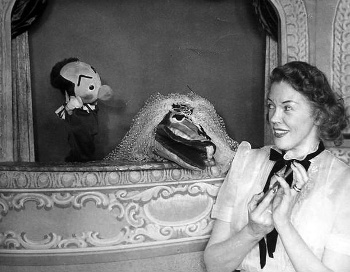
Kukla, Fran, and Ollie.
The Kukla, Fran, and Ollie television program, which ran from 1947-1954 on the NBC television network, is my first memory of television.
Ollie, the one-toothed dragon is evidence that dragons were as popular with children then as they are today.
Naming a character, "Kukla," especially a dragon, would be quite unlikely, today.
(Wikimedia Commons image)
Noise and communications have a
history that extends beyond my DTV problems. The pioneering work in
information theory by
Claude Shannon (1916-2001) showed that the most
efficiently coded message is indistinguishable from
random noise (
white noise). While the signal will appear as just noise to a casual listener (
her name, of course, would be Carol), it would be recovered perfectly by a properly coded receiver.
Carol is a
character in the
Alice-Bob-Carol cryptographic communications
scenario who acts as an
eavesdropper in a conversation between Alice and Bob. One way that Alice and Bob can try to thwart Carol from intercepting and reading their
letters is by
encrypting them with a secret code. Another would be by sending multiple letters that contain each
phrase,
word, or
character, of the message through different
post offices, thereby complicating Carol's interception. This can be done by radio using different transmission
frequencies in a technique called
spread spectrum communication. Spread spectrum is also a way to more reliably transmit a signal in a
noisy radio environment.
Spread spectrum has a history that's nearly as long as the
history of radio, and this is summarized in an article in
American Scientist magazine by
Tony Rothman,[2] a
theoretical physicist at
New York University who has
published numerous non-fiction and fiction books, and hundreds of general interest articles.[3] A short
timeline of spread spectrum communication follows:
•1899 - Guglielmo Marconi (1874-1937) performs the first experiments on multiple frequency communication as a means to mitigate interference.
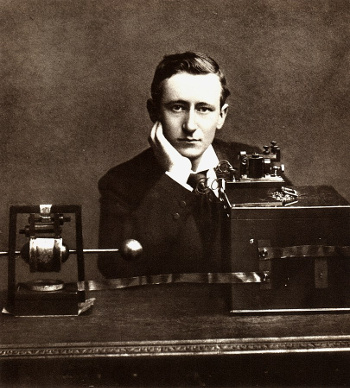
A publicity photo of radio pioneer, Guglielmo Marconi (1874-1937), with an early radio transmitter (left), and radio receiver (right).
The transmitter was a spark gap transmitter similar to the demonstration device of Heinrich Hertz (1857-1894).
(Wikimedia Commons photo from the Smithsonian Institution Libraries, accession number SIL14-M001-13)
![]() •1903 - Nikola Tesla disclosed a multiple frequency, frequency hopping, technique in US patent no. 725,605, "Method of Signaling," March 17, 1903, as a means of communication without interference.[4]
•1903 - Nikola Tesla disclosed a multiple frequency, frequency hopping, technique in US patent no. 725,605, "Method of Signaling," March 17, 1903, as a means of communication without interference.[4]
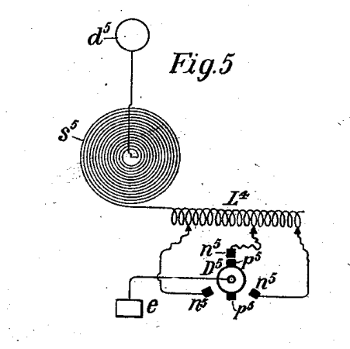
Fig. 5 from US Patent 725,605, "Method of Signaling," by Nikola Tesla, March 17, 1903.
In this figure, the antenna is d, ground connection is e, and the resonant frequency is cycled through three values by the motorized switch at D.
(Nikola Tesla, US patent no. 725,605, "Method of Signaling," March 17, 1903, via Google Patents.[4])
![]() •1914-1918 - war stimulates innovation, and Germany used frequency hopping spread spectrum during World War I to prevent British eavesdropping.
•1914-1918 - war stimulates innovation, and Germany used frequency hopping spread spectrum during World War I to prevent British eavesdropping.
•1929 - Innovation sparked by military concerns also led to the creation of the Polish electronics company, AVA Radio Company. In 1929, an engineer of AVA, Leonard Danilewicz, proposed a frequency-hopping spread spectrum system to the Polish military. Danilewicz, in a book by Władysław Kozaczuk[5], as quoted on Wikipedia, said, "...we proposed to the General Staff a device of my design for secret radio telegraphy which fortunately did not win acceptance, as it was a truly barbaric idea consisting in constant changes of transmitter frequency. The commission did, however, see fit to grant me 5,000 złotych for executing a model and as encouragement to further work." AVA also designed decryption equipment for the ciphers of the German Enigma rotor cipher machine.[5]
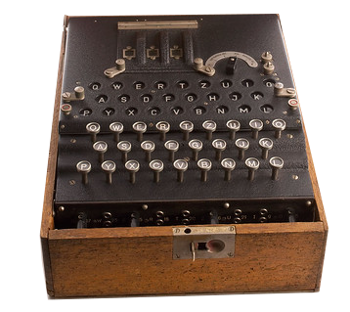
Keyboard portion of the German Enigma rotor cipher machine.
This electomechanical device offered 1.5 x 1020 different encryptions, but 10% of all German Enigma messages were decoded at Bletchley Park, England, through use of Alan Turing's electromechanical computer, called the Bombe.
(Portion of a Wikimedia Commons image from the US Central Intelligence Agency Flickr Site.)
![]() •1932 - Willem Broertjes was granted US patent no. 1,869,659 for a simple frequency hopping transmitter, as shown below. This patent, "Method of maintaining secrecy in the transmission of wireless telegraphic messages," was issued on August 2, 1932.
•1932 - Willem Broertjes was granted US patent no. 1,869,659 for a simple frequency hopping transmitter, as shown below. This patent, "Method of maintaining secrecy in the transmission of wireless telegraphic messages," was issued on August 2, 1932.
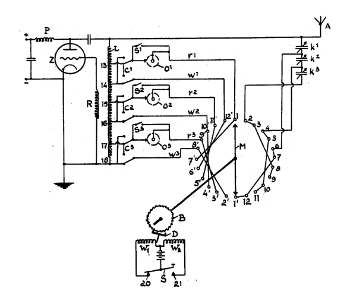
Figure from US patent no. 1,869,659 by Willem Broertjes.
Combinations of inductance and capacitance are selected to change the frequency of a vacuum tube oscillator.
The first claim of the patent reads, "Method for the wireless transmission of telegraphic messages by means of Morse or other code, wherein the dots and dashes of which the message is composed are transmitted by means of a plurality of working frequencies which are interchanged at will during the transmission of the massage."
(Willem Broertjes, "Method of maintaining secrecy in the transmission of wireless telegraphic messages," US patent no. 1,869,659, August 2, 1932 (via Google Patents).[6])
![]() •1942 - Alan Turing also had a hand in the development of the Bell Telephone Laboratories spread spectrum communications device called SIGSALY, a device classified as secret and unknown to the public for forty years. Bell Labs created the device for the US Army Signal Corps in 1943. The prototype device was named Green Hornet, since it sounded like the buzzing hornet theme of The Green Hornet radio show on a conventional receiver. We should be thankful for integrated circuitry, since SIGSALY could only be implemented in the electronics of the 1940s by 50 tons of equipment requiring 30 kilowatts of electrical power. The system was used to encrypt conversations between US President, Franklin D. Roosevelt and British Prime Minister, Winston Churchill.
•1942 - Alan Turing also had a hand in the development of the Bell Telephone Laboratories spread spectrum communications device called SIGSALY, a device classified as secret and unknown to the public for forty years. Bell Labs created the device for the US Army Signal Corps in 1943. The prototype device was named Green Hornet, since it sounded like the buzzing hornet theme of The Green Hornet radio show on a conventional receiver. We should be thankful for integrated circuitry, since SIGSALY could only be implemented in the electronics of the 1940s by 50 tons of equipment requiring 30 kilowatts of electrical power. The system was used to encrypt conversations between US President, Franklin D. Roosevelt and British Prime Minister, Winston Churchill.
•1942 - When a new chemical element is created, it's page three news. When a celebrity is sighted in a supermarket, it's front page news on many tabloids. That's why many articles have been written about the involvement of actress, Hedy Lamarr (1914-2000), in spread spectrum communications. In 1942, Lamar and avant-garde composer, George Antheil (1900-1959), were granted U.S. patent no. 2,292,387, "Secret Communications System."[7] Antheil was familiar with the mechanism of a player piano, which was intended as the sequencer of frequencies in their system intended for radio-guided torpedoes, but never built.
Rothman writes in his American Scientist article that California Institute of Technology engineer, Samuel Mackowen, guided Antheil and Lamar's description of their Invention, and he may have even written the patent application.[2] Not obvious to the inventors, but obvious to me, is that a music box mechanism with pins on a cylinder would be a more practical approach, since it eliminates the need for pneumatics. Lamarr and Antheil were posthumously inducted into the National Inventors Hall of Fame in 2014.

A player piano strip from Hedy Lamarr and George Antheil's frequency hopping spread spectrum patent. Older readers may have heard a short Antheil composition without realizing it. Antheil composed the music for the title sequence of the CBS News television documentary series, The Twentieth Century, hosted by Walter Cronkite, broadcast between 1957 and 1966. You can hear it in this YouTube Video.[8] (Fig. 4 from Hedy Kiesler Markey and George Antheil, "Secret communication system," US patent no. 2,292,387, August 11, 1942 (via Google Patents.[7])
•1942 - Nearly coincident with the Lamar-Antheil patent was the issuance of US patent no. 2,294,129, "System for reducing interference," to Ellison Purington on August 25, 1942.[9] Purington proposed a frequency modulation of the amplitude-modulated carrier wave that's somewhat like a frequency-hopping system.
•1943 - Henry Parks Hutchinson of the US Army Signal Corps applied for a patent on a "Speech privacy apparatus" on January 7, 1943. In his case, the technology was thought to be too sensitive to be made public (something that also happened to one of my patent applications), so publication of US patent no. 2,495,727 was delayed until January 31, 1950.[10] Hutchinson's idea was to use an electronically-generated pseudorandom sequence to generate the frequency hops.[10]
•2006 - Frequency hopping communication only works if the receiver is synchronized with the transmitter to anticipate the movement from one frequency to another. In 2006, Ray Zinn was granted US patent no. 6,996,399 for a method to communicate without synchronization if only low data rates are required, as for garage door openers. The receiver rapidly sweeps through the list of possible frequencies looking for the transmitter.[11]
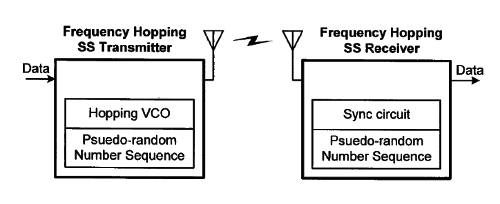
Fig, 2A of Zinn's US patent no. 6,996,399 showing prior art.
The first claim of his patent reads, "Device and method in a frequency hopping spread spectrum wireless communication system allow reception without the need to lock in synchronous steps with the frequency hopping channels. The transmitter will operate in the frequency hopping mode while the receiver operate in a frequency sweeping mode. The receiver has an IF pass band that effectively sweeps rapidly across the frequency hopping channels to intercept the active channel in the transmission spectrum. A less expensive radio could be manufactured while eliminating the complex receiver synchronization in the conventional frequency hopping scheme." (Ray Zinn, "Wireless device and method using frequency hopping and sweep modes," US patent no. 6,996,399, February 7, 2006 (via Google Patents).[11])
One advantage of spread spectrum signals is that they distribute their power over a wide bandwidth, thereby reducing their interference with other signals. The
United States Federal Communications Commission, in its
CFR 47 part 15.247 rules, has allowed more powerful spread spectrum signals to be broadcast in the
unlicensed 902-928 MHz, 2400-2483.5 MHz bands.[12] There is a requirement for a minimum number of frequency channels and a maximum
dwell time at each channel.[12]
A spread spectrum technology not related to communication is one with which I did research in the
1990s to create a
sensitive rangefinder for distances up to a few
meters. That's
micropower impulse radar, invented at
Lawrence Livermore National Laboratory.[13-14] Conventional
radar transmits
bursts of radio waves at a particular frequency, but MIR transmits short
pulses with inherently wide bandwidth, the final bandwidth being limited by the
antenna. The
Fourier transform shows that a sufficiently short pulse can have a bandwidth of hundreds of
MHz. As the patent indicates, 200
picosecond pulses will
penetrate gypsum,
wood, and
concrete walls, so MIR
sensors can be
hidden.[14]
References:
- NASA Jet Propulsion Laboratory/California Institute of Technology Voyager Website.
- Tony Rothman, "Random Paths to Frequency Hopping," American Scientist, Volume 107, no. 1 (January/February 2019), pp. 46-53. A PDF file of the article can be found here.
- One example of his accessible physics articles is Tony Rothman, "The Forgotten Mystery of Inertia," American Scientist, vol. 105, no. 6 (November/December 2017), pp. 344ff. As stated in the tagline, "A century after Ernst Mach and Albert Einstein cast doubt on absolute space, we still don't know how a gyroscope stays pointed in a fixed direction."
- Nikola Tesla, US patent no. 725,605, "Method of Signaling," March 17, 1903 (via Google Patents).
- Władysław Kozaczuk, "Enigma: How the German Machine Cipher Was Broken, and How It Was Read by the Allies in World War Two," Christopher Kasparek, Trans. (1984, University Publications of America), ISBN 0-89093-547-5.
- Willem Broertjes, "Method of maintaining secrecy in the transmission of wireless telegraphic messages," US patent no. 1,869,659, August 2, 1932 (via Google Patents).
- Hedy Kiesler Markey and George Antheil, "Secret communication system," US patent no. 2,292,387, August 11, 1942 (via Google Patents.
- CBS News "The Twentieth Century" Opening Theme music composed by George Antheil, YouTube Video by Fifth Continent, January 12, 2014.
- Ellison S Purington, "System for reducing interference," US patent no. 2,294,129, August 25, 1942 (via Google Patents).
- Henry Parks Hutchinson, "Speech privacy apparatus," US patent no. 2,495,727, (filed 1943-01-07) January 31, 1950 (via Google Patents).
- Ray Zinn, "Wireless device and method using frequency hopping and sweep modes," US patent no. 6,996,399, February 7, 2006 (via Google Patents)
- Federal Communications Commission, CFR 47 Part 15.247 Rules, Operation within the bands 902-928 MHz, 2400-2483.5 MHz, and 5725-5850 MHz.
- Micropower Impulse Radar (MIR), Lawrence Livermore National Laboratory Website.
- Thomas E. McEwan, "Ultra-wideband radar motion sensor," US patent no. 5,361,070, November 1, 1994 (via Google Patents).
Linked Keywords:
NASA; communication; communicate; Voyager 1 spacecraft; interstellar medium; interstellar space; mile; astronomical unit; AU; radio wave; Earth; anger; New York City; television station; digital television (DTV) transition in 2009; power (physics); transmitter; home; analog signal; vestigial sideband; amplitude modulation; video; frequency modulation; audio frequency; hertz; MHz; signal; FM broadcasting; FM radio receiver; noise (video); colloquial; scramble; multipath interference; Kukla, Fran, and Ollie; television program; NBC; television network; tooth; dragon; popularity; popular; child; children; character (arts); Ku Klux Klan titles; Ku Klux Klan, Origin of the name; Wikimedia Commons; noise (electronics); history; information theory; Claude Shannon (1916-2001); efficiency; efficient; code; randomness; random; white noise; Alice and Bob; Alice-Bob-Carol; cryptography; cryptographic; scenario; eavesdropping; eavesdropper; letter (message); encrypting with a secret code; phrase; word; alphabet character; post office; frequency; frequencies; spread spectrum communication; electromagnetic interference; noisy radio environment; history of radio; American Scientist magazine; Tony Rothman; theoretical physics; theoretical physicist; New York University; non-fiction and fiction books; general interest articles; timeline; Guglielmo Marconi (1874-1937); experiment; electromagnetic interference; publicity photo; radio transmitter; radio receiver; spark gap transmitter; Heinrich Hertz (1857-1894); Smithsonian Institution Libraries; Nikola Tesla; frequency hopping; United States patent law; US patent; antenna (radio); ground (electrical); electrical conductor; connection; resonance; resonant frequency; electric motor; motorized; electric switch; Google Patents; war; stimulation; stimulate; innovation; Germany; World War I; United Kingdom; British; military; Poland; Polish; electronics; company; AVA Radio Company; engineer; Leonard Danilewicz; book; Władysław Kozaczuk; secrecy; secret; wireless telegraphy; radio telegraphy; barbarian; barbaric; idea; Polish z%C5%82oty; złotych; physical model; Germany; German; Enigma rotor cipher machine; keyboard; electromechanics; electomechanical; encryption; Bletchley Park, England; Alan Turing; electromechanical computer; Bombe; US Central Intelligence Agency Flickr Site; inductance; capacitance; frequency; vacuum tube; electronic oscillator; patent claim; radio; wireless transmission; electrical telegraph; telegraphic; Morse code; dots and dashes; Bell Labs; Bell Telephone Laboratories; SIGSALY; classified information; US Army Signal Corps; prototype; hornet<; theme music; The Green Hornet radio show; integrated circuit; ton; equipment; kilowatt; electrical power; President of the United States; Franklin D. Roosevelt; Prime Minister of the United Kingdom; British Prime Minister; Winston Churchill; chemical element; news; celebrity; supermarket; newspaper; front page news; tabloid; actress; Hedy Lamarr (1914-2000); avant-garde; composer; George Antheil (1900-1959); mechanism (engineering); player piano; cam timer; sequencer; torpedo; California Institute of Technology; invention; patent application; music box; pins on a cylinder; pneumatics; posthumous; posthumously; National Inventors Hall of Fame; piano roll; strip; musical composition; title sequence; CBS News; television documentary series; The Twentieth Century; Walter Cronkite; mroadcasting; broadcast; YouTube Video; coincidence; coincident; US patent no. 2,294,129; carrier wave; technology; electronically-generated; pseudorandom number generator; synchronization; synchronize; Ray Zinn; bit rate; data rate; garage door opener; intermediate frequency; IF; passband; frequency spectrum; manufacturing; manufacture; complexity; complex; United States Federal Communications Commission; CFR 47 part 15.247 rules; unlicensed; dwell time; 1990s; sensitivity (electronics); sensitive; rangefinder; meter; micropower impulse radar; MIR; Lawrence Livermore National Laboratory; radar; wave packet; burst; pulse (physics); Fourier transform; picosecond; penetration depth; penetrate; gypsum; wood; concrete; wall; sensor; hidden; Nikola Tesla, US patent no. 725,605, "Method of Signaling," March 17, 1903; Willem Broertjes, "Method of maintaining secrecy in the transmission of wireless telegraphic messages," US patent no. 1,869,659, August 2, 1932; Hedy Kiesler Markey and George Antheil, "Secret communication system," US patent no. 2,292,387, August 11, 1942; Ellison S Purington, "System for reducing interference," US patent no. 2,294,129, August 25, 1942; Henry Parks Hutchinson, "Speech privacy apparatus," US patent no. 2,495,727, (filed 1943-01-07) January 31, 1950; Ray Zinn, "Wireless device and method using frequency hopping and sweep modes," US patent no. 6,996,399, February 7, 2006; Thomas E. McEwan, "Ultra-wideband radar motion sensor," US patent no. 5,361,070, November 1, 1994.